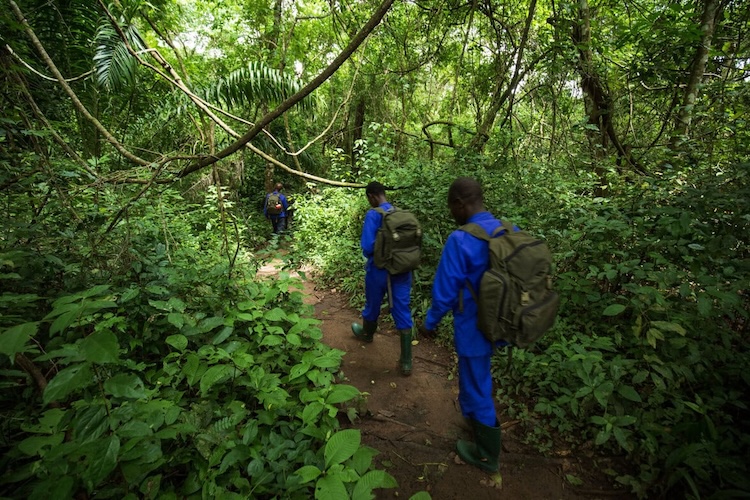By Ngala Killian Chimtom
YAOUNDÉ, Cameroon | 7 January 2025 (IDN) — Conflict in South Sudan has historically had a negative impact on wildlife, but the conservation of the area’s wildlife is now being used to catalyze the move towards reconciliation and peace.
Michelle Moeller, South Sudan Country Manager of conservation charity, Fauna & Flora in an exclusive interview with IDN said that “decades of war led to deep poverty and food insecurity, which has been one of the drivers of nature loss”.
Now, the organization is bringing communities around conservation, with Moeller saying that it can also diffuse tensions.
 “Nature can be a uniting force that helps encourage dialogue and cooperation between warring factions or neighboring countries,” she told IDN.
“Nature can be a uniting force that helps encourage dialogue and cooperation between warring factions or neighboring countries,” she told IDN.
Following are excerpts of the interview:
IDN: There is a general perception that biodiversity is always at great risk in situations of conflict. How true is this perception in the case of South Sudan and are there other countries where conflict has been a threat to conservation?
Michelle Moeller (MM): Conflict can of course have a damaging impact on nature. In the case of South Sudan, decades of war led to deep poverty and food insecurity, which has been one of the drivers of nature loss, and people, with no other options, try to make ends meet and hunt to feed their families. With a period of relative peace comes opportunity to protect wildlife in partnership with government and local people.
IDN: Can you explain how conservation efforts can help mitigate conflict and promote peace in regions like South Sudan?
Michelle Moeller (MM): Fauna & Flora has been working in what is now South Sudan since our foundation in 1903, when concern for the future of the area’s wildlife provided the catalyst for the founding of our organization. Since then, we have gained decades of experience in navigating conservation activities in areas of conflict and post-conflict and since 2011; continue to work with partners in South Sudan to protect the country’s biodiversity.
Our work centers around partnering with the Ministry of Wildlife Conservation and Tourism and local communities to improve the sustainable management of natural resources, with a focus on three key protected areas and protecting functional corridors of connectivity to link them — Southern National Park and Bire Kpatuo and Bangangai Game Reserves. We support rangers to address illegal wildlife trade taking a human rights-based approach, and unsustainable resource extraction and protecting habitats and the species living within them, whilst providing sustainable livelihood opportunities for those that live closest to nature.
Civil unrest has continued to affect South Sudan even since its independence as a nation. When South Sudan first became independent, one of the most pressing priorities for our conservation work was the provision of conservation training and equipment to the wildlife service, and the development of basic infrastructure, to boost relationships amongst local communities and inspire confidence in the wildlife service.
As well as catalytic relationship building between communities and the wildlife service, we are working to create trust among groups for what would otherwise potentially be rival groups. By bringing different communities together — to provide training, to provide livelihood activities — conservation acts as a facilitator, and it can also diffuse tensions. In addition, some communities receive benefits — such as the provision of beehives — from conservation activity and so see the value of supporting the work.
IDN: What are some successful examples of conservation contributing to peace building in other conflict-affected areas?
MM: Fauna & Flora works in other areas that have been affected by conflict — including Liberia and the Virunga Massif which straddles Rwanda, Uganda and the Democratic of Congo.
Nature can be a uniting force that helps encourage dialogue and cooperation between warring factions or neighboring countries. A shared interest in conserving economically valuable species and their ecosystems can promote peace building through, for example, co-signing and joint enforcement of international agreements; trans boundary collaboration to conserve species whose range straddles international borders or tackle illegal wildlife trade; management of shared marine resources.
In South Sudan whilst we are wholly independent and work in partnership with the Ministry of Wildlife Conservation and Tourism, our approaches are consistent with wider peacekeeping efforts and, through community cohesion around natural resources management and agricultural development, support United Nations Mission in South Sudan’s (UNMISS) goal of building durable peace and inclusive governance.
Fauna & Flora’s values and strategy include a deeply embedded approach to respond to locally identified needs; develop solutions aligned with local priorities; build local capacity; and contribute to national and local priorities relating to nature conservation, poverty alleviation, food security, and peace and stability. Our work also seeks to achieve biodiversity conservation and multidimensional poverty reduction; leveraging and building evidence to scale locally successful solutions; and scaling approaches to create greater impact for people and nature.
IDN: How do you engage local communities in conservation projects to foster peace and cooperation?
MM: In Bangangai National Park and Bire Kpatuo, our teams work alongside several Community Wildlife Ambassadors, representatives from the communities living close to the parks who support the management of the protected areas.
The role of the Community Wildlife Ambassadors is varied; due to their familiarity with the landscape, they play a key part in wildlife monitoring activities, navigating the field and identifying the locations of wildlife. The Community Wildlife Ambassadors then host meetings where they feedback to the wider community about their findings and raise awareness of local biodiversity. In a recent report commissioned by Fauna & Flora, which explored the evidence-base for locally-led approaches to protected area management, one of the key findings was the importance of keeping local actors informed about conservation progress: “Regular reporting of progress (or reasons for lack of progress) and results is important, both to reassure the people most directly affected that promises are being kept, and more subtly to maintain communication channels between different groups.”
In addition to fostering active participation in conservation activities, our work with local communities in South Sudan often focuses on building sustainable livelihood activities. For example, we have established beekeeping in many communities; providing an alternative source of income and food, and therefore reducing reliance on hunting.

IDN: What role do traditional leaders and local governance structures play in your conservation and peacebuilding efforts in South Sudan?
MM: In a society where kinship and local leadership is so deeply respected, some of the key champions within the Community Wildlife Ambassadors and communities engaging in conservation activities are traditional leaders. In addition, faith-based organizations and the leaders within those play an important role in engaging communities in conservation awareness and the importance of biodiversity for all life on earth.
IDN: How do you measure the impact of conservation on peacebuilding in the communities you work with?
MM: Multi-dimentional and relational wellbeing indicators are used to understand perceived safety and how people feel about insecurity more generally. These monitoring tools are embedded into our work and give an insight into how wildlife conservation and working in partnership with wildlife authorities brings a perceived safety to a community that would otherwise not have that level of safety. When listening to what communities and rangers say, it is often the fact that we have remained throughout that has brought a sense of safety and trust in the communities with whom we partner.
IDN: What challenges do you face in aligning conservation goals with peacebuilding objectives, and how do you overcome them?
MM: Peace is good for both people and nature and has as its very foundation fair and equitable governance. Good governance helps in building strong community relationships which creates a virtuous circle of peacebuilding and in turn has benefits for conservation.
As a biodiversity conservation organization, our objective is to protect and restore nature, while ensuring the rights and well-being of those people living closest to nature are respected and supported. Our objectives is to take a conflict sensitive approach which is an important piece in the overarching puzzle to achieving peace between people and nature and making conservation work and be sustainable for the long term.
IDN: How do international organizations and agreements support your work in using conservation as a tool for peace?
MM: Essential to tackling biodiversity loss is working with local people and understanding their local context. We know that different people around the world live with, experience and value nature in a variety of ways, and therefore understanding that relationship is critical to developing conservation solutions that benefit both our planet’s vital ecosystems and the people living closest to nature.
Big international agreements — like those that will be made at COP16 — must recognize the value of locally-driven conservation action. This means unlocking finance for local actors; prioritizing locally-led approaches to protected area management; and ensuring that emerging solutions are developed with the rights and needs of those living alongside nature integral to that development.
International organizations, especially development organizations, are actively engaging in the climate and environment conversations and activities, as well as international aid, reaching communities that would otherwise be remote and outwit the mainstream funding and development opportunities. In engaging the humanitarian sector in environment and conservation sectors, people come together around a common objective which is protection biodiversity for the benefit of people, and ensure development is resilient to climate shocks through locally led adaptation such as flood/drought resistant crop varieties to ensure food security and using tools such as early warning systems in predicting extreme climate events such as flooding.
Other international strategies, such as the UK Foreign Commonwealth and Development Office’s Strategy for International Development (IDS) UK-South Sudan policy aims to strengthen resilience to conflict, climate, and economic shocks, by better understanding climate vulnerability which aligns with our work in Western Equatoria on supporting diversified, climate-resilient livelihoods that reduce vulnerabilities to shocks; and building community-level understanding of climate impacts.
Conservation requires a holistic approach and peacebuilding/conflict sensitive approach is a big part of that. Fauna & Flora works to ensure that nature and people are able to thrive together and prioritizing peace at community, regional and national level is crucial in that. [IDN-InDepthNews]
Photo: Southern National Park, one of the key focus areas for conservation in South Sudan, Credit: Fauna & Flor


